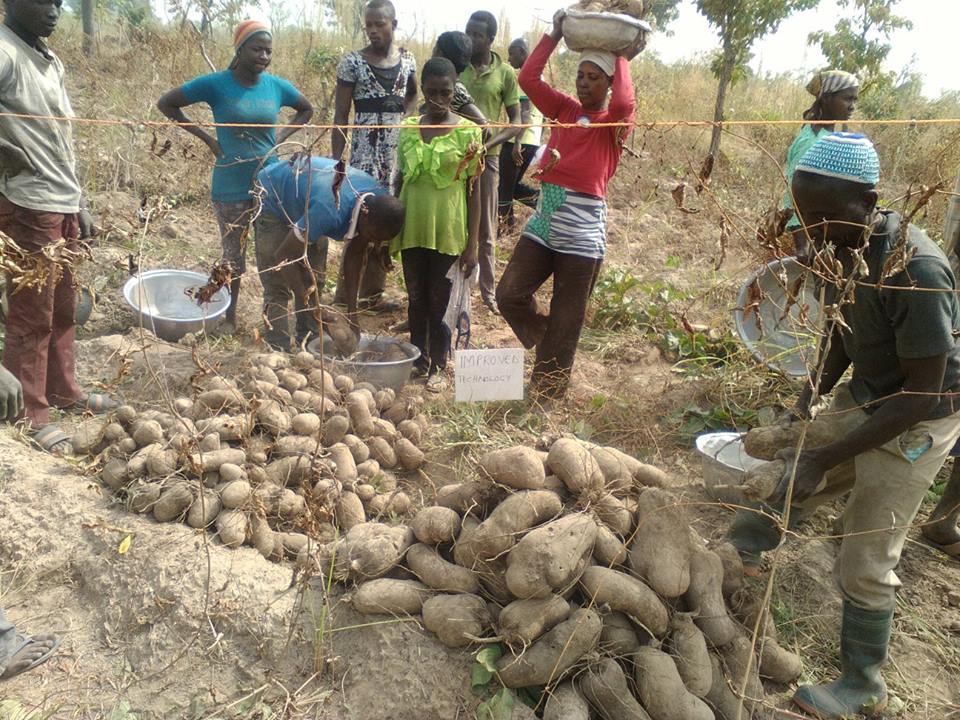
By Kofi Adu Domfeh
Farmers at Nyomoase in the Atebubu-Amantin Municipality of the Brong Ahafo Region are happy to embrace an improved technology in yam production.
The farm is the classroom where the farmers and research scientists get themselves busy with the soil to learn how to better produce yam for higher income and reduction in drudgery.
At the end of eight months in field activities – planting and assessment of vegetative stage, an examination is undertaken by way of harvest and evaluation of the differences in crop yields between an introduced improved technology and the farmers’ practice.
Sumaila Rufai, a 32 year-old father of four, is enthused at the new knowledge of generating multiple planting materials of seed yam.
“We have been very wasteful with the use of seed yams,” he observed. “For instance, instead of planting a seed on one mound, now I know I can do that on 4-5 mounds”.
This and other best agronomic practices are off-shoots of the technology introduced to the farmers.
The participatory approach is the best to encourage farmers to adopt new agricultural technologies, according to research scientists from the Crops Research Institute (CRI) of the Council for Scientific and Industrial Research (CSIR).
The introduction of the “Improved Agronomic Technologies for Sustainable Yam Production” involves the use of mechanized ridges and minimum staking per unit area, dubbed “trellis”, as well as fertilizer application on continuously cropped fields.
“…and you can see the yield as we weigh is about 35-50percent increase on the ridges as compared to the farmers’ practice and you can see the sprout rate was better on the ridges as compared to the mounds,” noted Eric Owusu Danquah, a Yam Agronomist leading the project.
The Project is under the West Africa Agriculture Productivity Programme (WAAPP), funded by the World Bank. Trials are taking place on selected farmers’ fields within Ejuraand Atebubu-Amantin yam producing agro-ecological zones of Ghana. .
The five-year project ends in 2017 and already the technology developers are satisfied with the rate of adoption.
Hannah Adade is a 65-year old mother of seven. She has been supporting her husband in yam production for over 40 years, long enough to appreciate the benefits of the improved production technology.
“We have more yield now growing yam on ridges than with mounds,” she said. “I encourage other farmers to come on board to also benefit”.
The use of the mechanized ridges reduces drudgery, which encourages women like Madam Hannah to venture into yam production for improved livelihoods.
Yam is a major food crop and Ghana is a lead exporter of the commodity.
Generally, yam produced with mounds give larger tubers but it is difficult to meet the export market requirements. Ridges however give sizable weight for export and also help in preservation.
The researchers are collaborating with the Ministry of Food and Agriculture to fabricate and make available Mechanized Ridgers at vantage points to ease farmers’ access to go into production.
At Nyomoase, the farmers and researchers took the risk of planting the yam in drought, as the rains failed to pour in June and July, 2015.
“Even planting in drought you can see that the yields are still better,” said Mr. Owusu Danquah after harvesting the yam in December, touting the climate-reliance of the technology.
Farmers, traditionally, are inclined to clear new fields for yam production, in which process they contribute to deforestation and depletion of carbon sinks that eventually leads to climate change.
“We are encouraging farmers to plant on continuously cropped fields and that means they’ll not open up new areas, so at least we have our carbon sinks intact; and this is a technology which uses ropes and few stakes, so the farmers do not have to fell trees for staking. So this is climate resilient,” Mr. Owusu Danquah said.
Ghanaian farmers, like many others in Sub-sahara Africa, rely heavily on the rains to produce food.
The poor downpour in 2015 severely affected food production in Ghana, a situation that threatens food security in 2016.
Felix Frimpong, a research scientist focused on climate resilient crop production, says the adoption of climate smart agricultural practices is the way to go for Ghanaian farmers.
“We need to support the farmers with fertilizer subsidies, resilient crop varieties and farming technologies, increased diversification of agriculture systems, promotion of simple irrigation facilities, we need to also train them and advocate that the old ways of farming need to change to ensure increased productivity and climate resilient,” he stated.










